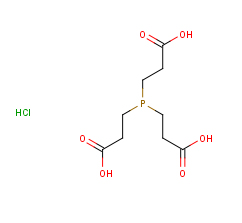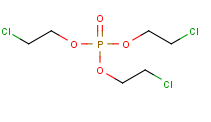We often use English abbreviations to facilitate writing and use for chemical substances, however, sometimes it is easily confused. This article will introduce two substances, the English abbreviation is exactly the same, both are TCEP, but the roles of them are very different.
TCEP—tris(2-carbonylethyl)phosphate hydrochloride, CAS No. 51805-45-9, trivalent phosphorus derivatives for disulfide reduction.

It is usually used as TCEP.HCl. The disulfide bond is a covalent bond between the sulfur atoms of the -S-S- formed by the oxidation of two mercapto groups, which plays an important role in the formation of the three-dimensional structure of the protein molecule. In order to determine the primary structure of the protein, the disulfide bond must be opened firstly to make it a linear polypeptide chain. TCEP reduction of disulfide bond is a quantitative reaction process, the principle is that the center atom "P" with the soliton pair can form a coordination covalent binding with oxygen atoms and has a reduction
TCEP is colorless, tasteless, soluble in water, has a high stability in air and aqueous solution, and there is a small impact by the temperature and concentration; the reaction is mild, low toxicity, easy to operate, the reducing capacity is strong, the effect can be maintained for 2~3 weeks. TCEP is highly selective for reducing disulfide bonds. Except for cysteine, there is almost no side reaction with other amino acids, and can be used under acidic conditions to effectively reduce the hydrolysis of amide bonds. It is recognized as the best disulfide reduction reagent.

Flame retardants are additives used to improve the flame resistance of materials, mainly for flame retardant synthesis and natural polymer materials. The material containing the flame retardant is not easily ignited, can inhibit the flame propagation, contribute to secure use of a variety of products. With the rapid development of electronic products, large-capacity lithium-ion battery research has attracted a lot of domestic and foreign scientific research interests. The main obstacle is the safety problem, especially in the abuse state (such as thermal shock, overcharge, over discharge, short circuit, etc.), there is risk of fire, explosion and so on. So it needs to add flame retardant additives in the electrolyte to improve the safety performance of the battery, so that even in the abuse of the battery it does not produce combustion and explosion.
Additive flame retardant tris(β-chloroethyl)phosphate is a colorless transparent liquid, industrial products are with light yellow, insoluble in aliphatic hydrocarbons, slightly soluble in water, soluble in alcohol, ketones, esters, can be miscible with chloroform and carbon tetrachloride, and the compatibility is better with cellulose acetate and other high polymer; it has good flame resistance, excellent resistance to low temperature and anti-ultraviolet. As a flame retardant, it not only can improve the flame retardant material flame retardant level, and can improve the water resistance and acid resistance of flame retardant materials. Tris(β-chloroethyl)phosphate can not only absorb the heat generated by the external environment of the battery and the heat realeased by the reaction of negative and the electrolyte, and the decomposition of the product Ethyl chloride has a strong cooling effect, can significantly improve the safety of the battery, it is a more ideal flame retardant.
In the use of chemical substances, the English abbreviation of the application is very broad, only the correct distinction between these abbreviations, we could correctly apply these substances, and for the substances with same English abbreviation, we should distinguish them carefully through their CAS number, It is better to know the charactors of the products.
Copyright © Suzhou Yacoo Science Co., Ltd. All Rights Reserved
Friendly Links :
online service